This creamy chicken sun dried tomato pasta makes a quick, easy dinner that is loaded with delicious flavours. Tender pieces of chicken and al dente pasta are tossed through a gorgeously creamy sauce loaded with sun dried tomatoes, garlic, spinach and parmesan. And it’s ready to eat in just 20 minutes!
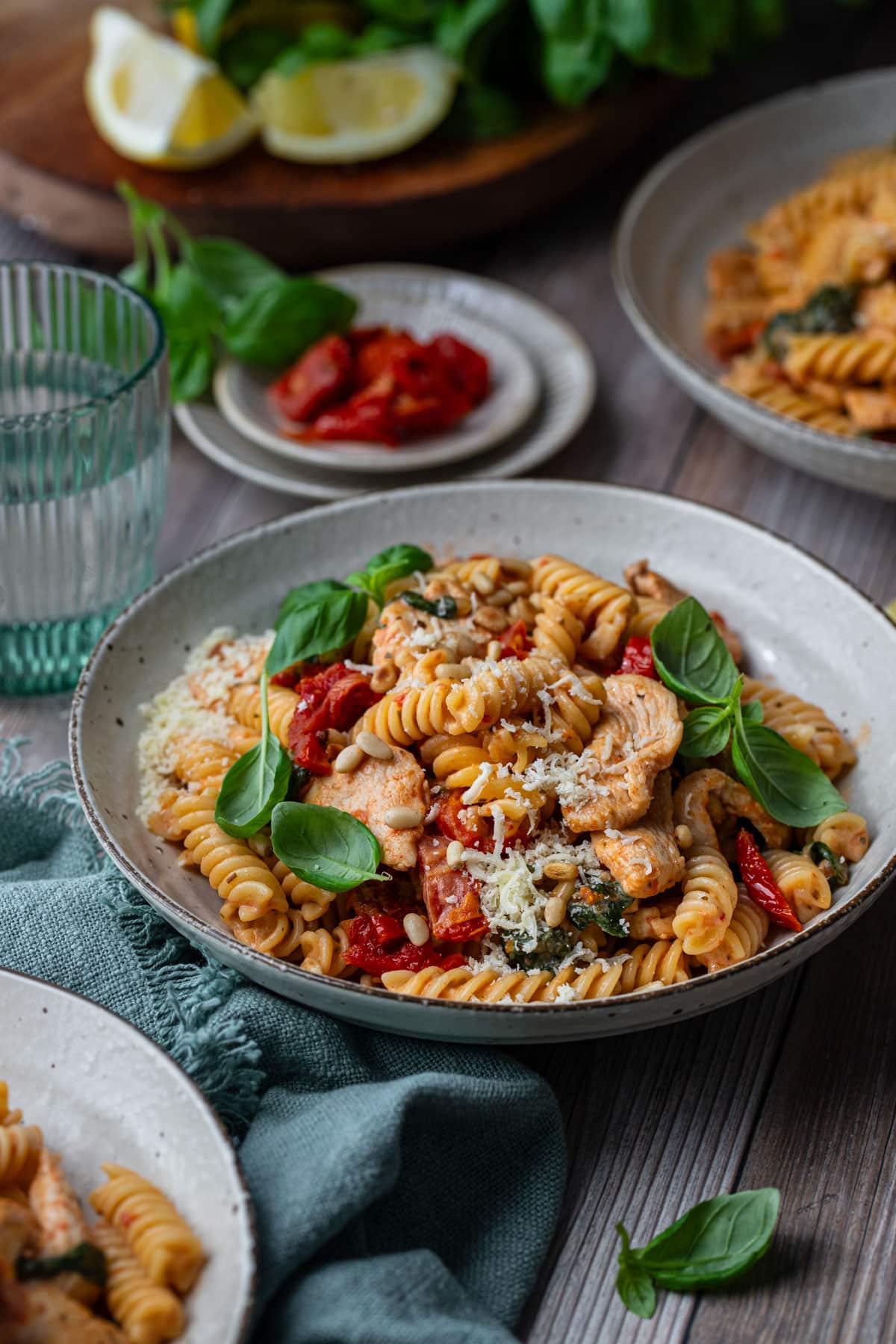
Why you’ll love this recipe
- Quick and easy – it’s an easy recipe that comes together in just 20 minutes. And it can be made even easier by using leftover chicken!
- Perfect for a fridge clean-out – it’s a great way to use up veggies from your fridge, a jar of sun-dried tomatoes or leftover chicken.
- It’s made with simple, everyday ingredients from your fridge and pantry.
- That sauce – the creamy, cheesy sauce is irresistible! It’s big on flavour, with minimal effort.
- It’s perfect for tomorrow’s lunch – it reheats beautifully and leftovers are great for lunch the next day.
Ingredients you will need
** This post contains tips and instructions to achieve the best possible results. This photo is a great guide for when you are in the supermarket, but for full ingredient quantities and methods, please scroll down to the detailed recipe card below!
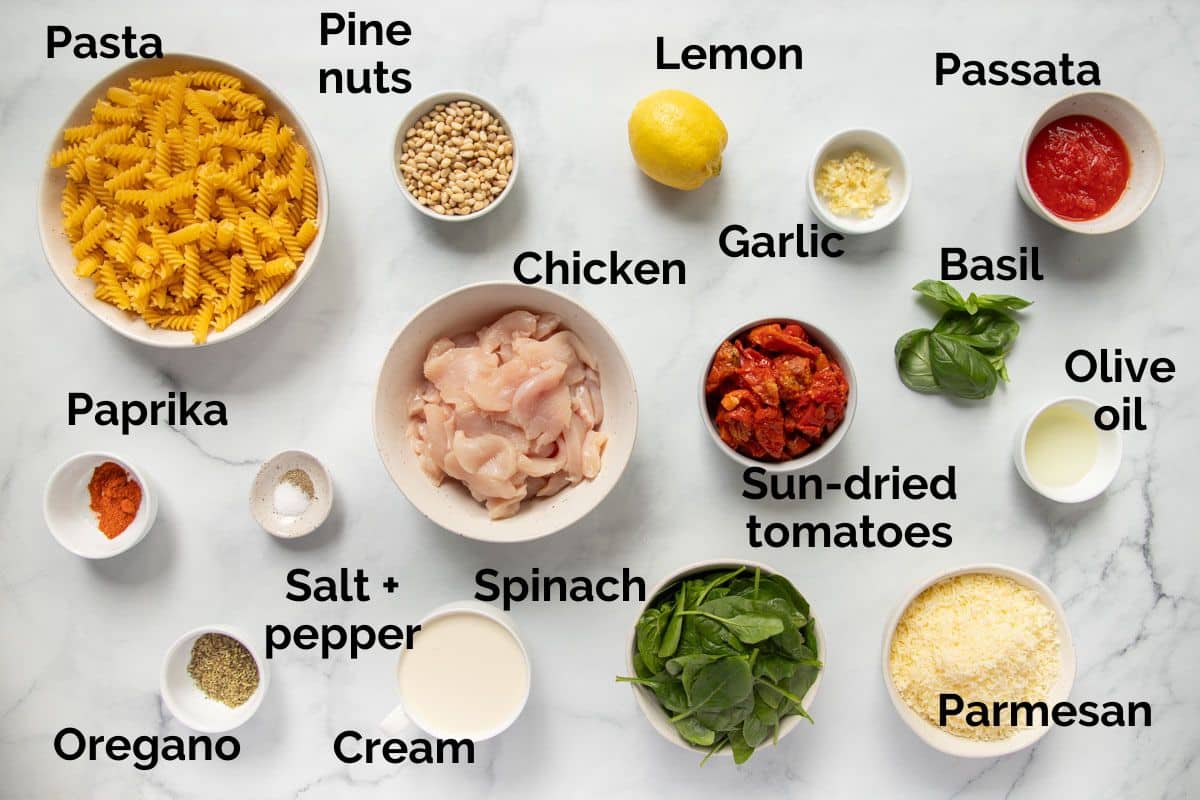
- Pasta – you can use any type of pasta you’d like for this recipe. I used trivelle pasta, but fusilli, bowtie, penne or long strands like pappardelle or fettuccine will work. Just be sure to cook the pasta to al dente and don’t forget to reserve some of the leftover pasta water before draining!
- Pasta water – starchy pasta water is used to bind and emulsify the cream sauce, making it creamy and silky. Once the pasta has cooked, reserve 1-2 cups of pasta water and set aside before draining the pasta. You won’t need to use this much, but any leftover pasta water can be frozen and used to help loosen the pasta when reheating.
- Chicken – I use skinless chicken breasts, but thighs can be used if you prefer dark meat. Leftover chicken like this air fryer roast chicken or a ready-cooked rotisserie chicken from the supermarket can also be used. If using chicken that has already been cooked, simply stir it through the sauce at the end until heated through.
- Parmesan cheese – an important ingredient, used to both flavour and thicken the pasta sauce. I recommend grating your own fresh parmesan, as pre-packaged shredded cheese won’t melt into the sauce and will clump together. Parmesan can be substituted for cheese with lots of flavour that will melt into the sauce, like Pecorino Romano, Grana Padano or Asiago.
- Paprika – ground paprika is used to season the chicken and flavour the sauce. Use sweet Hungarian paprika, not hot or smoked.
- Passata – for the tomato base of the creamy sauce. Alternatively, crushed canned tomatoes can be used in equal quantities. Choose plain tomatoes, with no added flavourings.
- Spinach – baby spinach leaves are a great way to add greens to the dish.
- Cream – heavy/thickened cream or cooking cream makes the sauce thick and creamy. If you’d like a lighter sauce, you can swap it for light cream; but the sauce will be a bit thinner and less rich in comparison. Cooking cream is recommended, as it makes a rich creamy sauce that won’t split.
Sun-dried tomatoes add a nice punch of tomato flavour to the sauce. They are made by leaving ripe tomatoes in the sun to dry for a few days, or in a dehydrator or oven. During this process, they lose about 90% of their weight but retain most vitamins and antioxidants.
There are two types of sun-dried tomatoes;
Dry-packed tomatoes have a highly concentrated tomato flavour and a chewy texture, similar to dried fruit. They are sold in plastic bags or packages and are commonly rehydrated in water or oil to plump them up before being used in cooking.
Oil-packed tomatoes are sun-dried tomatoes that are submerged in oil which commonly contains other flavours like herbs and/or garlic and sometimes vinegar. They are commonly sold in jars or containers from the supermarket or deli. Oil-packed tomatoes have a softer, juicier texture than dry-packed tomatoes and can be used straight from the jar. The flavourful oil can also be used as a base in dressings and pasta sauces. To use, drain the excess oil from the tomatoes and chop to size.
For this recipe, you will need oil-packed tomatoes. Choose your favourite oil-based sun-dried tomatoes that you know and love to eat. Additional flavourings in the oil like garlic and herbs are fine to use here. You can also try making your own!

Step by step instructions
Full ingredient notes and quantities can be found in the detailed recipe card below. But here is a brief overview of what you can expect;
- Boil the pasta. Bring a large pot of salted water to the boil and add your choice of pasta. Cook the pasta until al dente, according to the packet instructions. Reserve at least 1 cup of the salty, starchy pasta water before draining the pasta.
- Toast the pine nuts in a large frying pan with no oil, until browned but not burnt. Remove from the pan and set aside.
- Cook the chicken. Season the chicken pieces with salt, pepper and paprika. In a large frying pan coated with olive oil, sear the chicken until just cooked and then remove from the pan and set aside. (If using ready-cooked/leftover chicken, leave the chicken out until the end and add the paprika to the sauce instead.
- Make the creamy sauce. In the same pan, add the remaining olive oil, garlic and oregano and stir until fragrant (around 1 minute). Add the sun-dried tomatoes, passata and lemon juice and stir. Add the cream and simmer. Sprinkle the grated parmesan cheese over the top and stir, until melted and thickened. Add the reserved pasta water until the sauce reaches your desired consistency. Turn off the heat and add the spinach leaves, stirring until wilted.
- Toss in the pine nuts, chicken and drained pasta and stir well to coat. Garnish with basil and extra parmesan and serve immediately.
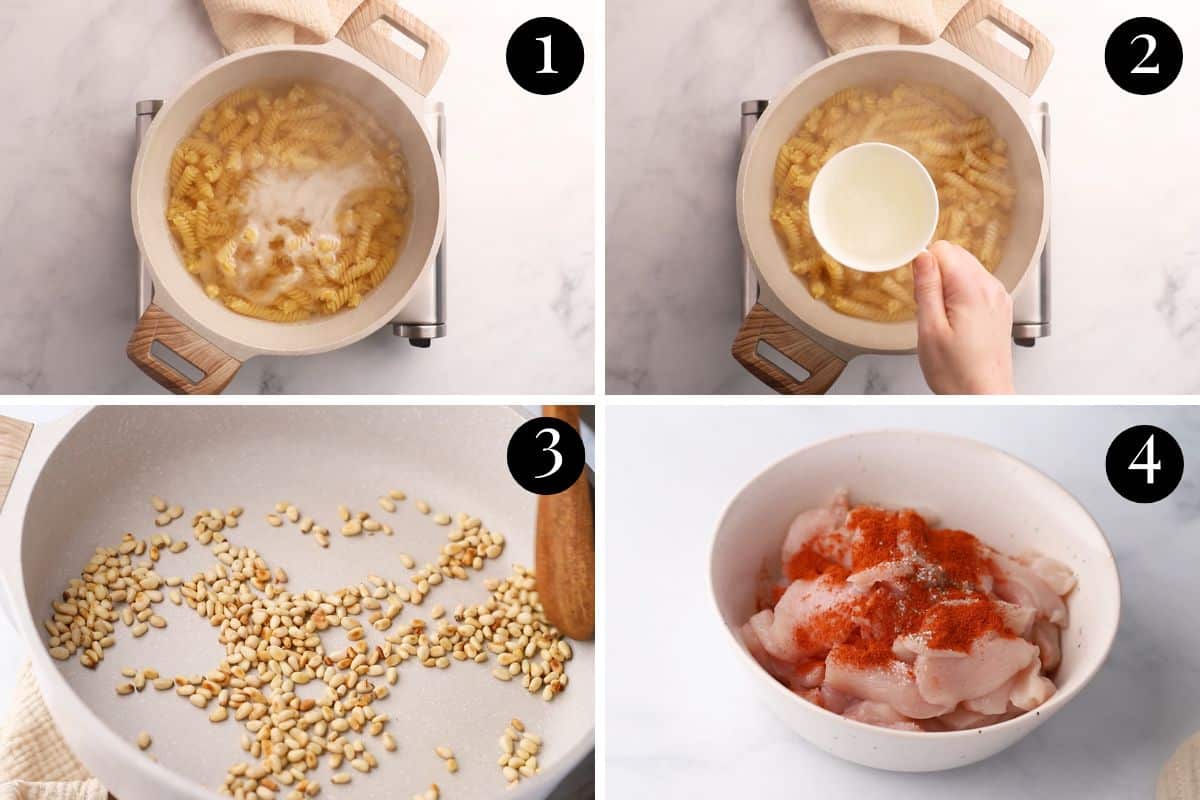
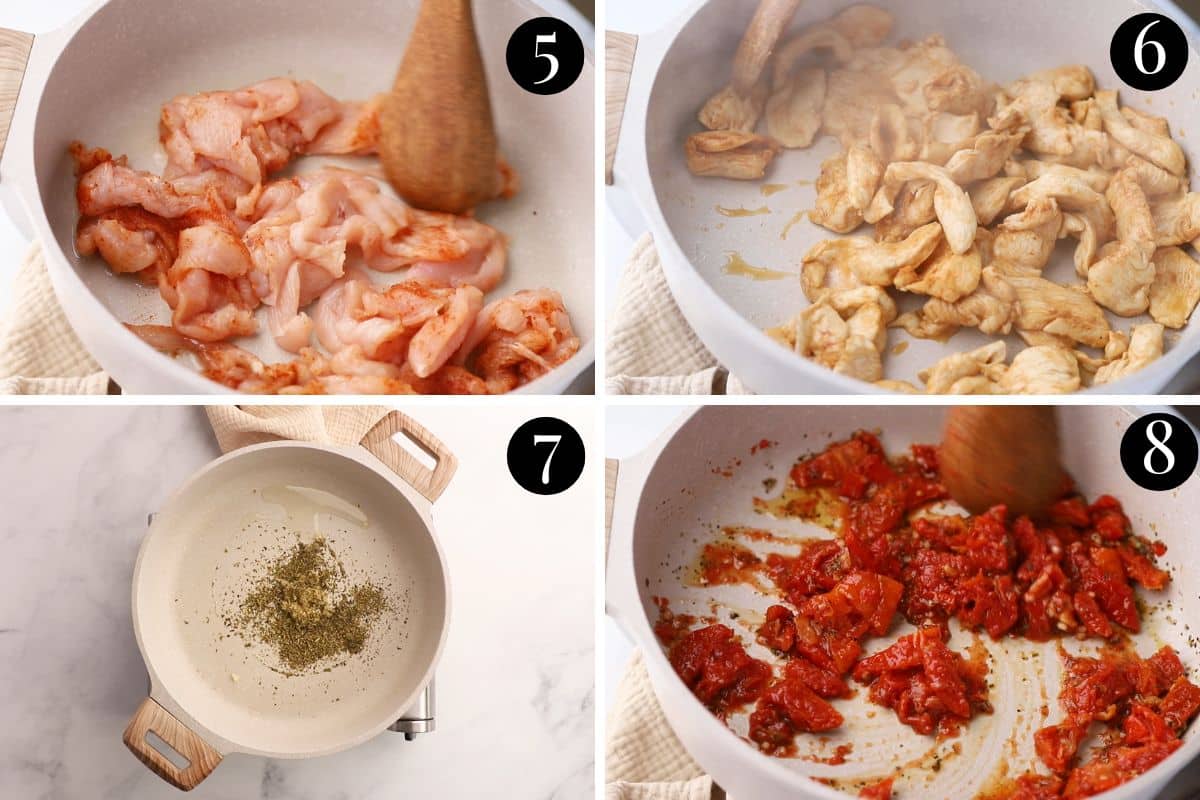
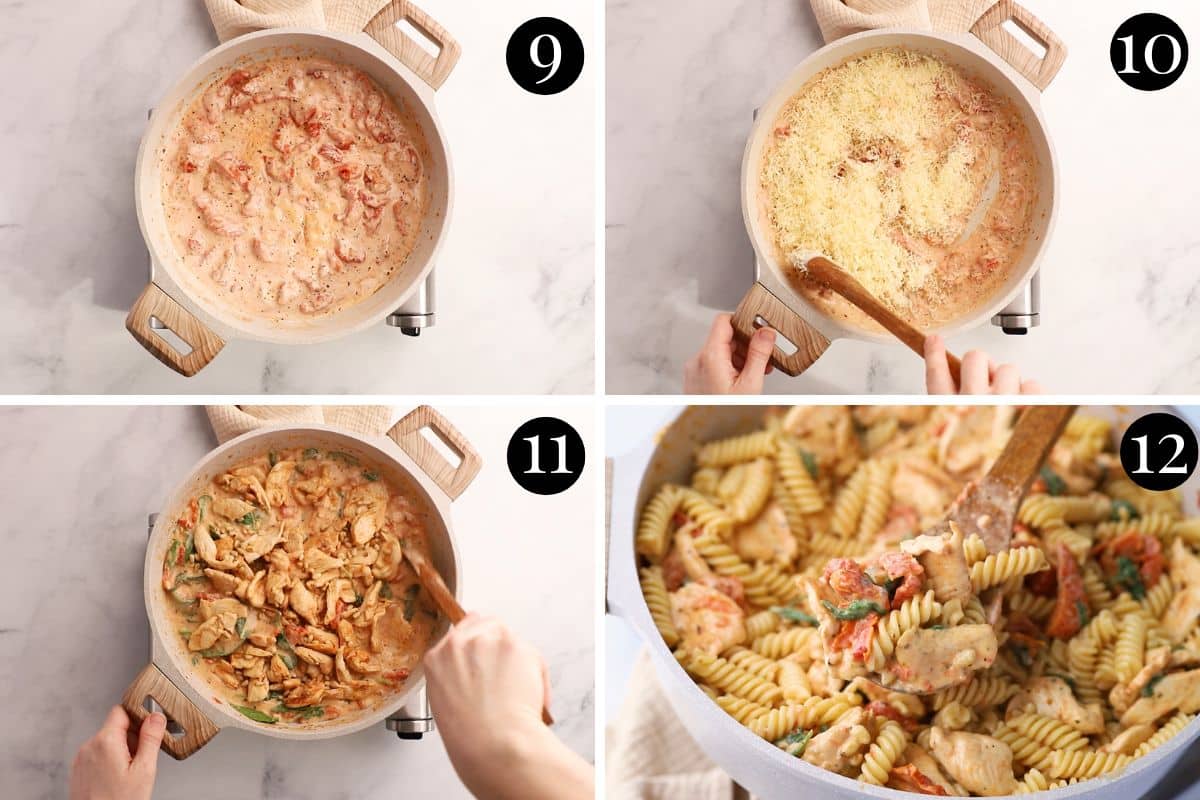
** Don’t forget to keep a little pasta water reserved before draining, to help thin the sauce and add flavour.
Expert tips
- When cooking the pasta, salt the water generously. Salting the pasta water will season the pasta as it cooks and add flavour to the sauce. I recommend about a teaspoon of salt for every litre of water.
- Make sure you reserve some of the pasta water before draining the pasta. It helps to bind and thin the sauce to your desired consistency and also makes it silky smooth and flavourful.
- Use a large frying pan to mix the pasta and sauce together without spilling.
- To save even more time, use some leftover chicken or a rotisserie chicken from the supermarket. Simply stir the cooked chicken through the hot sauce at the end, until it is completely heated through.
- Don’t overcook the pasta. Cook the pasta until al dente (just underdone, with some bite left). I recommend testing your pasta 1-2 minutes before the time specified on the packet. It will finish cooking in the sauce.
- Don’t overcook the chicken or it will become dry. Slice it thinly and sear in a hot pan until just cooked through before draining and setting aside. It will continue to heat through when added back into the sauce at the end.
- Add any additional vegetables from your fridge. Broccoli, zucchini, grilled asparagus or even a handful of olives are all great additions.
- Both the parmesan cheese and pasta water contain salt, so taste the sauce before adding extra salt.
- For extra savoury flavour, dissolve ¼ teaspoon of Vegemite into the creamy sauce. I highly recommend this!
- Serve the pasta immediately. It will continue to thicken and can dry out as it cools.
- To make it ahead, follow the recipe without the pasta and store the sauce in the fridge for up to 2 days. Reheat on the stove and add the pasta water to the sauce to thin it, followed by the fresh pasta.
FAQs
Allow the pasta to cool to room temperature, then transfer it to an airtight container. Store leftovers in the fridge for up to 2 days. The pasta will continue to soak up the sauce in the fridge, so it will need a generous splash of pasta water or chicken stock to loosen it up when reheating.
Reheat the pasta in a large pan on the stovetop, with an additional splash of reserved pasta water or chicken stock to loosen it up and keep it from drying out. Add enough stock/pasta water to revive the creamy sauce. Heat, stirring, until steaming hot.
If making ahead, I recommend freezing the sauce on its own and adding fresh pasta when ready to reheat and eat. However, any leftover pasta can be stored in an airtight container in the freezer and is best consumed within 2 months. Thaw overnight in the fridge before reheating with a splash of pasta water or chicken stock to loosen the sauce.
This pasta should be topped with additional parmesan cheese, fresh basil leaves and toasted pine nuts. You can even add some extra sun-dried tomatoes. While it makes a filling and complete meal on its own, it’s also amazing served with some crusty bread, toasted garlic bread or a side salad like this roast pumpkin salad or a simple green salad.
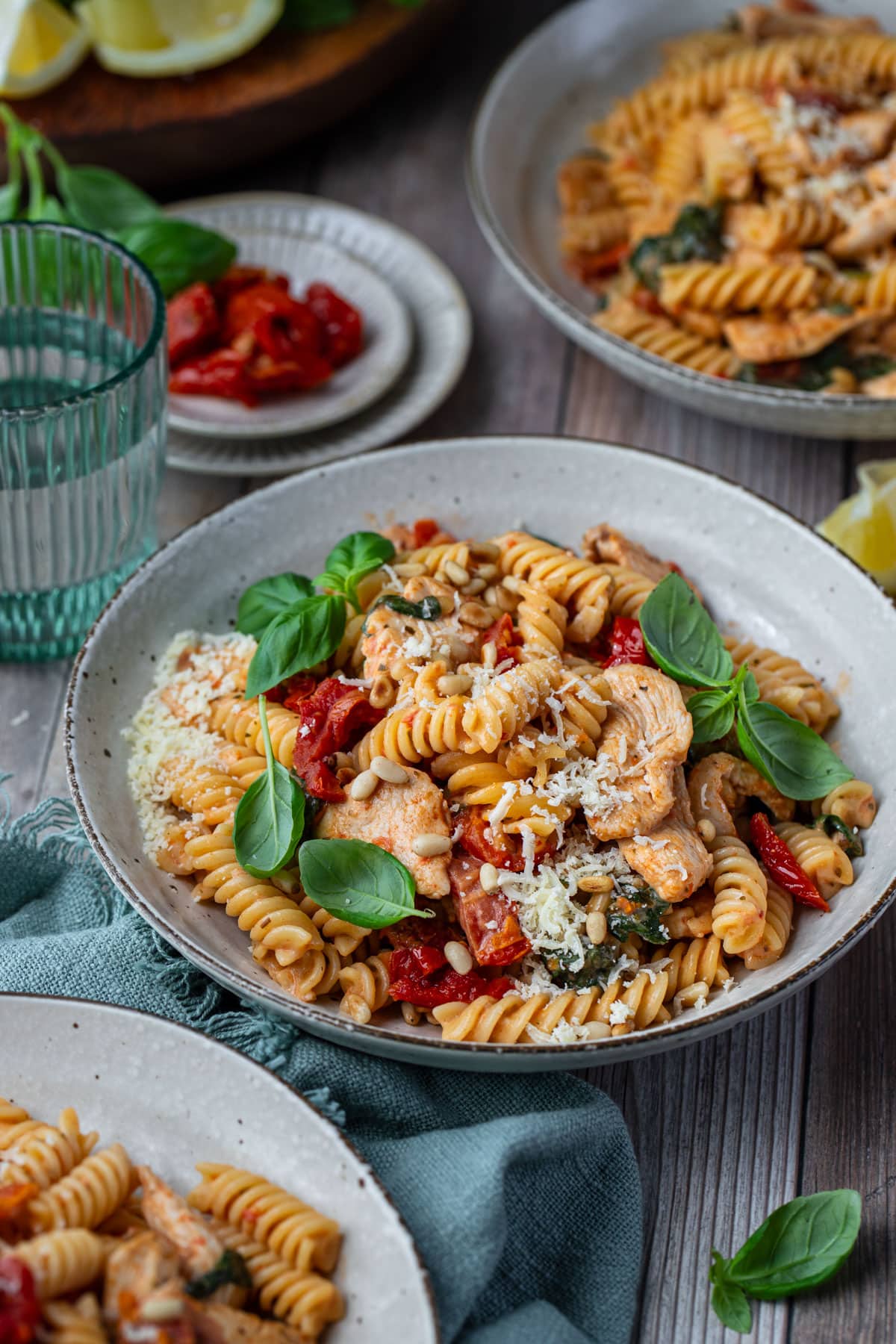
Related recipes
Tried this recipe? Please leave a star ⭐⭐⭐⭐⭐ rating or leave a review below and let you know how you went!
Hungry for more? Subscribe to my newsletter and follow along on Facebook, Instagram and Pinterest for the latest recipes and news.
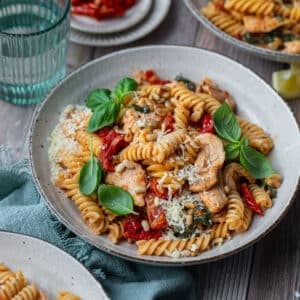
Chicken Sun Dried Tomato Pasta with Creamy Sauce
Ingredients
- 400 grams fresh or dried pasta trivelle, bow ties, penne, pappardelle or your favourite pasta
- ⅓ cup pine nuts
- 2 tablespoons olive oil plus a little extra
- 500 grams chicken breasts sliced thinly (for quick cooking), or use leftover, pre-cooked chicken.
- 4 cloves garlic finely crushed
- 1 teaspoon paprika Sweet Hungarian paprika (not hot or smoked)
- 1 tablespoon dried oregano
- salt and pepper to taste
- 1 cup oil-packed sun dried tomatoes about 300 grams, chopped
- ⅓ cup passata or crushed canned tomatoes
- 3 tablespoons fresh lemon juice
- 1 cup cream heavy or cooking cream
- 1 ½ cups parmesan cheese fresh, grated.
- reserved pasta water see notes
- 2 cups baby spinach leaves
To serve
- fresh basil leaves
- extra freshly grated parmesan cheese
Instructions
- Place the pasta in a pot of salted, boiling water (add about 1 teaspoon of salt per litre of water) and cook to al dente, according to the packet instructions (be careful not to overcook).
- When the pasta is cooked, reserve 1-2 cups of the starchy pasta water before draining the pasta and setting aside.
- While the pasta is cooking, start on the sauce.
For the sauce
- Add the pine nuts to a dry (no oil) frying pan and toast them over medium-low heat, stirring occasionally until the pine nuts are lightly browned. Remove the pine nuts from the pan and set aside.
- Season the thinly sliced chicken pieces with salt, pepper and paprika and stir to coat.
- Add half of the olive oil to the pan and heat over high heat. Add the chicken and cook on high until the chicken is just cooked through. Remove the chicken from the pan, drain and rest on a plate until the rest of the sauce is finished. Note: if you are using leftover or rotisserie chicken that is already cooked, leave the chicken out until the end. The paprika can be added directly to the sauce in this case.
- Reduce the heat to low and add the remaining olive oil to the pan. Add the garlic and oregano and cook for 1-2 minutes, until soft and fragrant.
- Add the sun dried tomatoes, canned tomatoes and lemon juice and stir until gently simmering.
- With the heat on low, gently stir through the cream and bring to a low simmer.
- With the heat on low, add the Parmesan cheese and cook for 1-2 minutes, stirring, until the cheese melts completely through the sauce.
- Start with adding ½ cup of the reserved pasta water and stir to combine. Add a little more pasta water if needed, a little at a time, until the sauce reaches your desired consistency.
- Turn the heat off and add the spinach leaves, stirring until they are wilted through the sauce.
- Taste the sauce and season further with salt and pepper, if needed.
- Add the chicken, pine nuts and drained pasta to the sauce and stir to combine. Spoon into bowls and serve immediately with basil leaves and additional grated parmesan.
Video
Notes
- Pasta – you can use any type of pasta you’d like for this recipe. I used trivelle pasta, but fusilli, bowtie, penne or long strands like pappardelle or fettuccine will work. Just be sure to cook the pasta to al dente and don’t forget to reserve some of the leftover pasta water before draining!
- Pasta water – starchy pasta water is used to bind and emulsify the cream sauce, making it creamy and silky. Once the pasta has cooked, reserve 1-2 cups of pasta water and set aside before draining the pasta. You won’t need to use this much, but any leftover pasta water can be frozen and is useful when reheating the sauce, to help loosen it.
- Chicken – I use skinless chicken breasts, but thigh fillets can be used if you prefer dark meat. Leftover chicken or a ready-cooked rotisserie chicken from the supermarket can also be used. If using cooked chicken, simply stir it through the sauce at the end until heated through.
- Parmesan cheese – an important ingredient, used to both flavour and thicken the pasta sauce. I recommend grating your own fresh parmesan, as pre-packaged shredded cheese won’t melt into the sauce and will clump together. Parmesan can be substituted for cheese with lots of flavour that will melt into the sauce, like Pecorino Romano, Grana Padano or Asiago.
- You will need oil-packed sun dried tomatoes for this recipe. If you like, you can even add a little of the flavoured oil to the sauce at the end for extra flavour.
- When cooking the pasta, salt the water generously. Salting the pasta water will season the pasta as it cooks and add flavour to the sauce.
- Make sure you reserve some of the pasta water before draining the pasta. It helps to bind and thin the sauce to your desired consistency and also makes it silky smooth and flavourful.
- Use a large frying pan to mix the pasta and sauce together without spilling.
- To save even more time, use some leftover chicken or a rotisserie chicken from the supermarket. Simply stir the cooked chicken through the hot sauce at the end, until it is completely heated through.
- Don’t overcook the pasta. Cook the pasta until al dente (just underdone, with some bite left). I recommend testing your pasta 1-2 minutes before the time specified on the packet. It will finish cooking in the sauce.
- Don’t overcook the chicken or it will become dry. Slice it thinly and sear in a hot pan until just cooked through. It will continue to heat through when added back into the sauce at the end.
- Add any additional vegetables from your fridge. Broccoli, zucchini, grilled asparagus or even a handful of olives are all great additions.
- Both the parmesan cheese and the pasta water contain salt, so try the sauce before adding extra salt to the sauce.
- For extra savoury flavour, dissolve ¼ teaspoon of Vegemite into the creamy sauce. I highly recommend this!
- Serve the pasta immediately. It can dry out as it cools.
- To make it ahead, follow the recipe without the pasta and store the sauce in the fridge for up to 2 days. Reheat on the stove and add the pasta water to the sauce, followed by the fresh pasta.
- Storage: Allow the pasta to cool to room temperature, then transfer it to an airtight container. Store leftovers in the fridge for up to 2 days. The pasta will continue to soak up the sauce in the fridge, so it will need a generous splash of pasta water or chicken stock to loosen it up when reheating.
- Reheating: Reheat the pasta in a large pan on the stovetop, with an additional splash of chicken stock or reserved pasta water to loosen it up and keep it from drying out. Add enough stock/pasta water to make the sauce creamy. Heat, stirring, until steaming hot.
- Please note that the nutrition information is based on the pasta being divided into 4 bowls, with each bowl being one serve. The nutritional information is an estimate only and does not take into account any other sides or toppings served with the pasta.
- This recipe is made using Australian cups and spoon measurements. Due to cup sizes varying from country to country, I advise adjusting if necessary.
Nutrition
Are you following us on Facebook, Instagram and Pinterest?
Update Notes: This recipe was originally published in March 2019, but was re-published with new information and photos in August 2023.


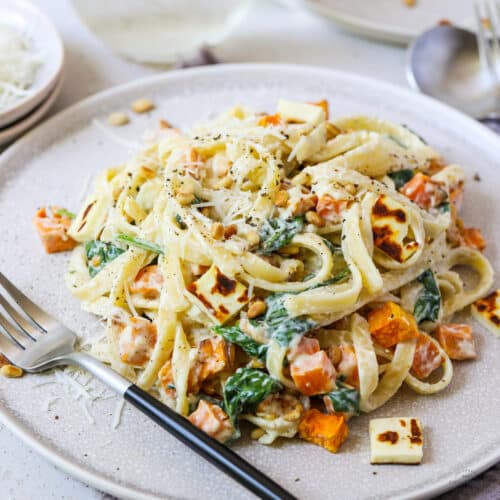
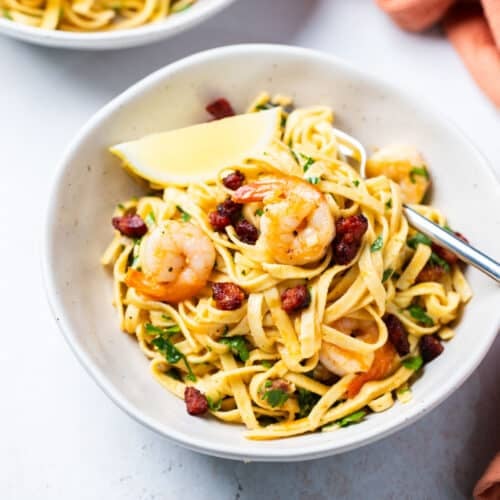
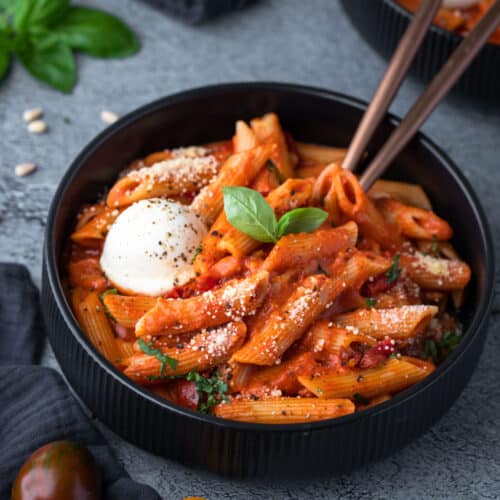
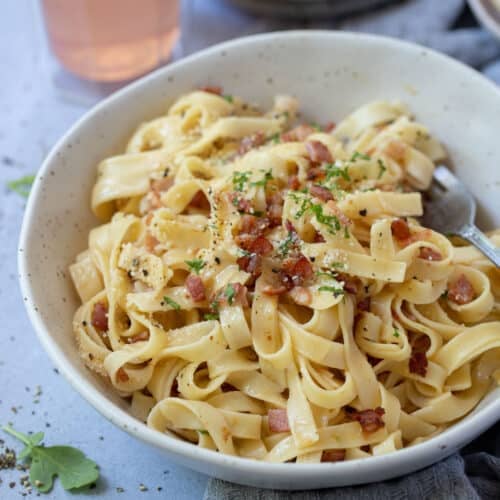

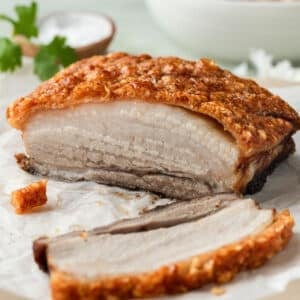

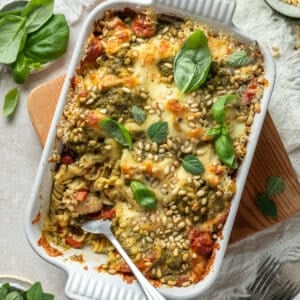
Leave a Reply